When last our story ended, Ryan, Jack and I had arrived at our hotel at 4am and fell asleep. We slept until noon and then took a long walk downhill. La Paz is a canyon. The Choqueyapu river flows through it but the river has been nearly completely built over so it is almost entirely underground — which is very good because it is now filled with the sewage of 2.3 million people. The city of La Paz sits in a bowl surrounded by mountains, volcanoes and the altiplano and was founded in 1548 by the Spanish conquistadors and originally named Nuestra Señora de La Paz (Our Lady of Peace). The city started in the valley and as it grew, it climbed the steep hills. From the bottom of La Paz to the top is more than 3,000 feet and hundreds of steep roads. La Paz has a section called El Alto which is the largest indigenous community on the planet. El Alto is at the top an spills over the rim onto the altiplano.
Our hotel was on a road that was the main market road with at least 12 full-time market roads, meaning roads that have markets set up with blue plastic tarps all day long, every day of the year and sell tooth paste, shoe laces, metal cups, real Cholita hair in 24″ braids, dog collars, potions, vegetables, every single part of any animal, knock off North Face Jackets, safety pins,toilet paper, song birds, blankets, old watches, refurbished ancient cell phones… So we had to wend our way through the market as went to and from our hotel.
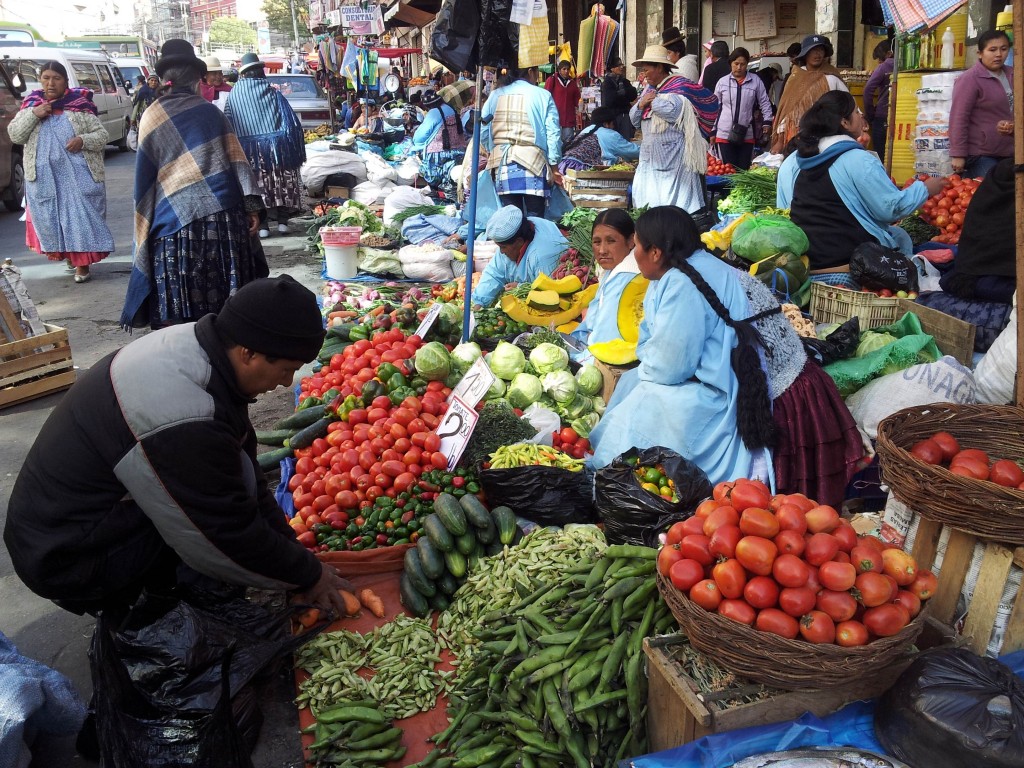
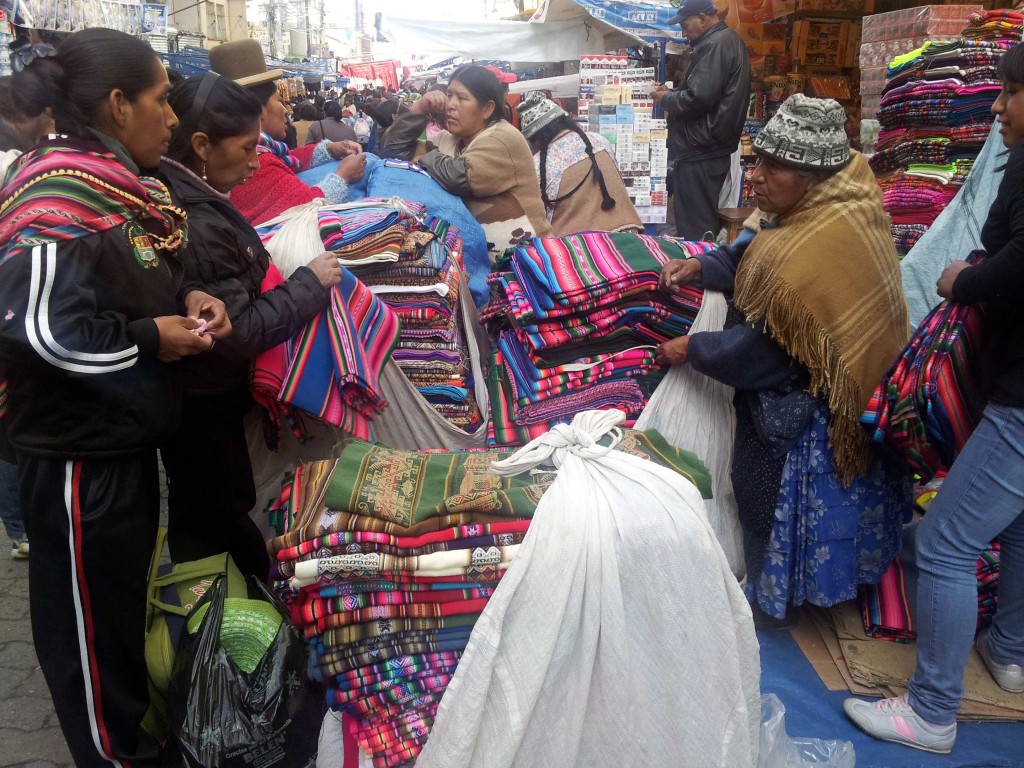
The day we arrived was May 1, International Workers’ Day, a national holiday in more than 80 countries including Bolivia. Perfect day to sit around a Bolivian cafe drinking espresso and plotting socialist reform. We took a long walk (all downhill) and we were amazed at how lovely, cosmopolitan and clean La Paz was! It was a truly beautiful city.
Over the next 5 days, we walked all over the city. We quickly figured out that it was easiest to leave our hotel, which was north of the city centre and uphill, and walk downhill as much as possible and return in the evening in a taxi. Still, we walked uphill quite a lot which, at 14,000+ feet is not such an easy task.
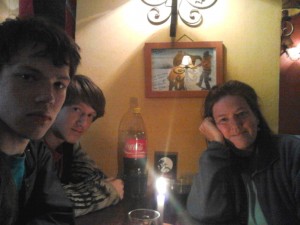
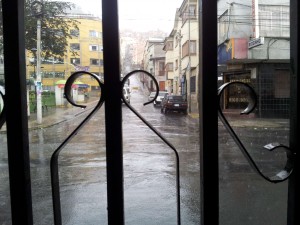
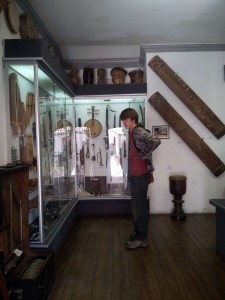
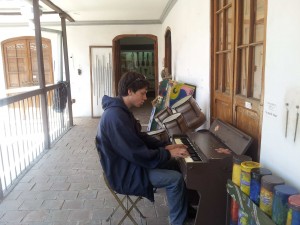
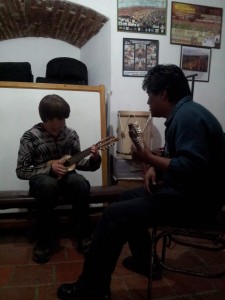
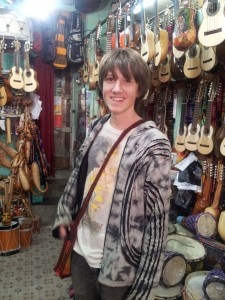
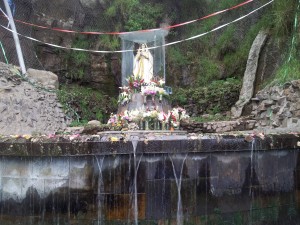
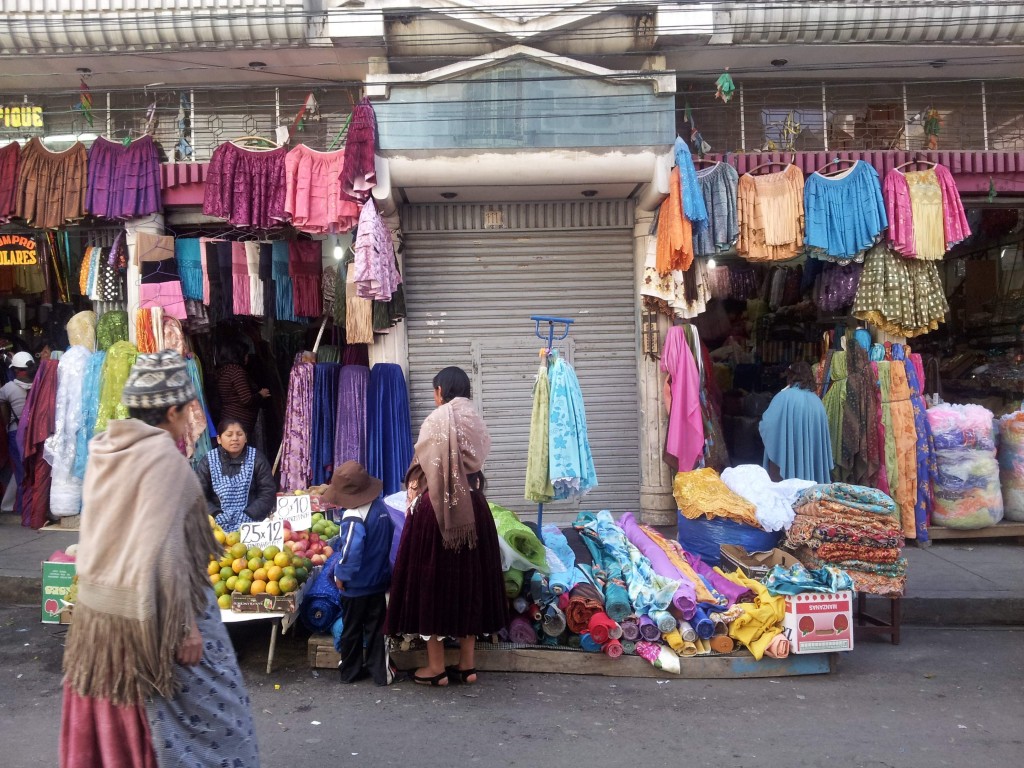
Despite being a very traditional city with many (mostly) traditionally dressed people, La Paz had thriving ex-pat communities and street signs were in Spanish, Hebrew and Japanese. We went out for excellent Japanese food at the Japanese Club of La Paz (#1 rated restaurant and a complete dinner for the three of us, including drinks and tip was less than $24). We ate falafels at a hookah bar. We had upscale coffee at several cafes with high speed wireless and much fanciness.
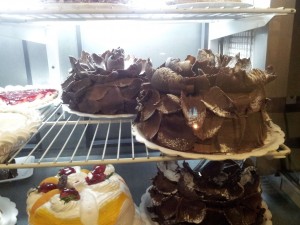
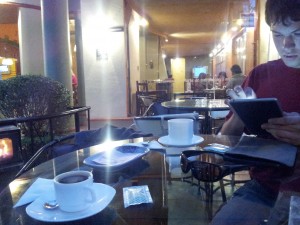
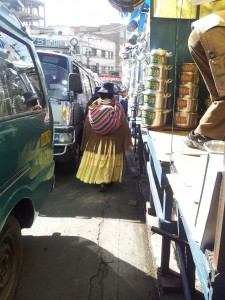
La Paz was very interesting because it was the best city I have ever been to for live music, restaurants, events, fountains, flowers, beautiful skyline and shopping. At the same time, it was a very traditional city where most men and women wore traditional clothing and it was common to see a woman in full Cholita outfit (a minimum of 6 skirts but as many as 22, several shawls, blankets used to carry personal items draped around your neck and the smallest bowler hat you could wear without pins) pull an Iphone out of their blanket to schedule a court case. The crafts were amazing, The quality of the handwork was unbelievable and I leave here with yet another skein of handspun alapaca yarn, a few dolls, felted slippers and handmade knitting needles.
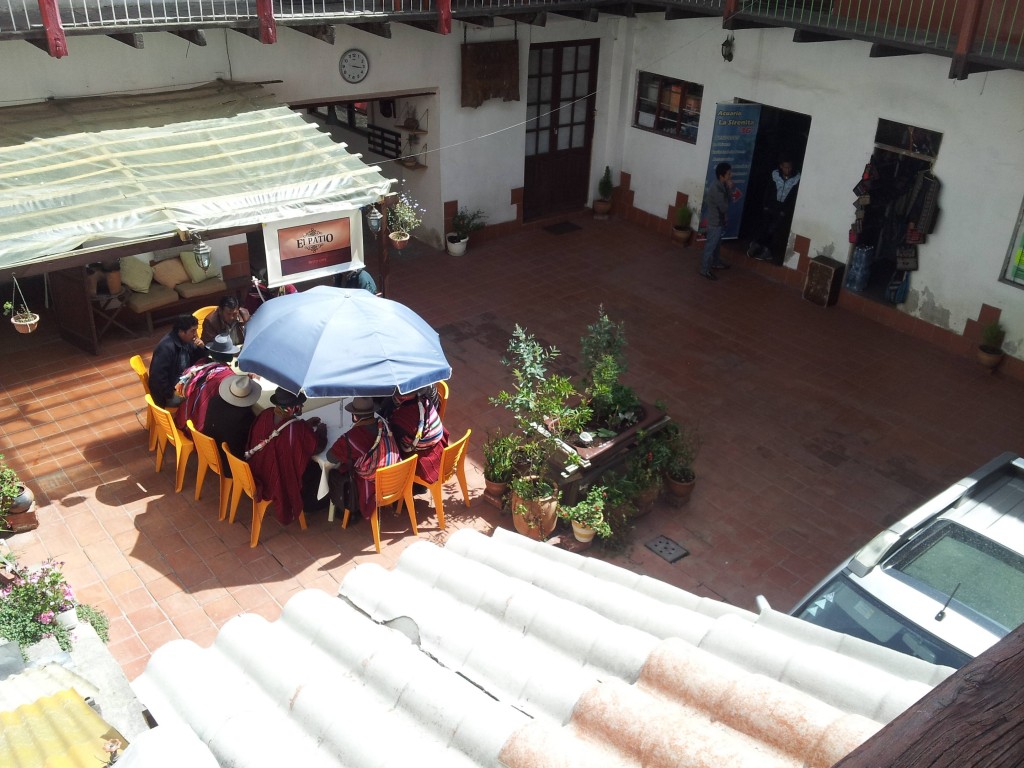
We saw a woman pluck an eyeball from a boiled sheep head and pop it into her mouth. We saw a man with a bucket of flattened rattlesnakes and a bowl of rattlesnake blood for sale.
We paid a few visits to the witches market. The Tourist Information Service of Bolivia estimates that there are llamas buried under 99% of the houses and under all of the fabulous skyscrapers. The bigger the building, the more extravagant the offering. A live llama, dressed in fine clothing and drinking chicha, is preferred. But if you cannot afford a live llama to sacrafice, a llama fetus will work. To meet the sacrificial requirements, La Paz has a bustling Witches Market that offers llama fetuses in all price ranges, from embryonic to viable llama. We asked how they got so many fetuses and the woman said that when llama meat is processed, the fetuses are sold to the witches. We brought with us a list of all the requests we had for potions and charms (you know who you are!!) and seriously and respectfully requested assistance. So we left with several powders, packets, talismans, charms, small bottles and one specially made wax voodoo doll and instructions.
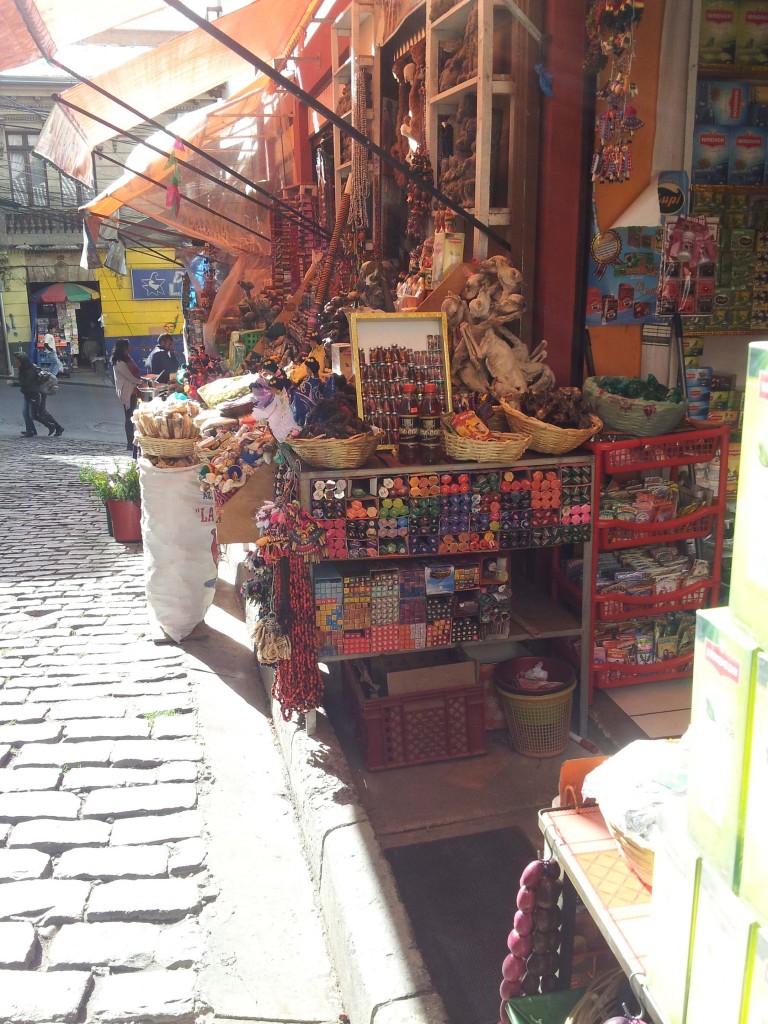
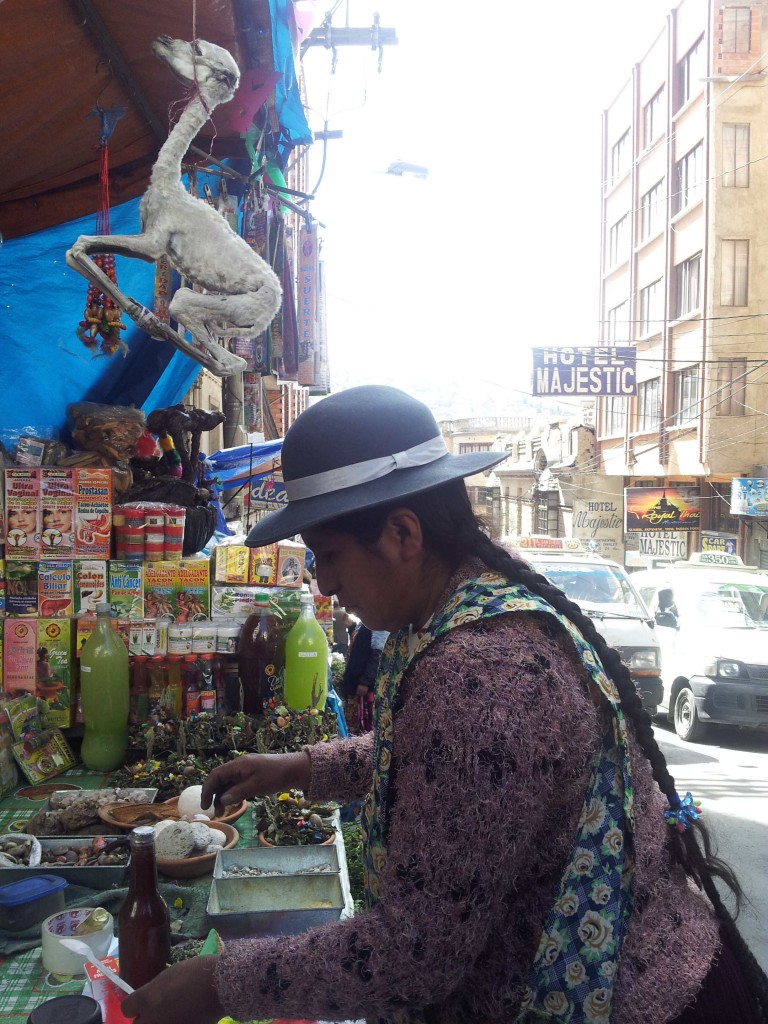
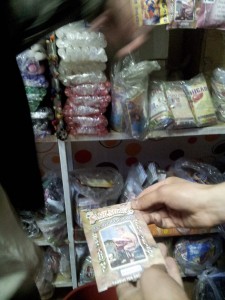
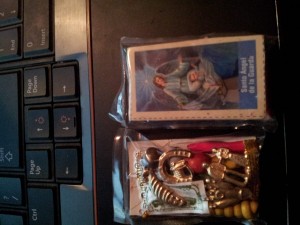
Bolivia’s traditional alcoholic drink is chicha, a whitish, sour brew made from fermented corn and drunk from a hemispherical bowl fashioned from a hollowed gourd (round-bottomed so you can’t put it down). Its very alcoholic and is sold by the glass from buckets all over the place. We didn’t try it. It always looked pretty disgusting, with something round floating in the bottom that I think was a pickled quail egg. Also it was more alcoholic than grain alcohol and morning seemed to be the time to drink chicha. You drank it there, no walking away with the glass, which was promptly refilled and reused.
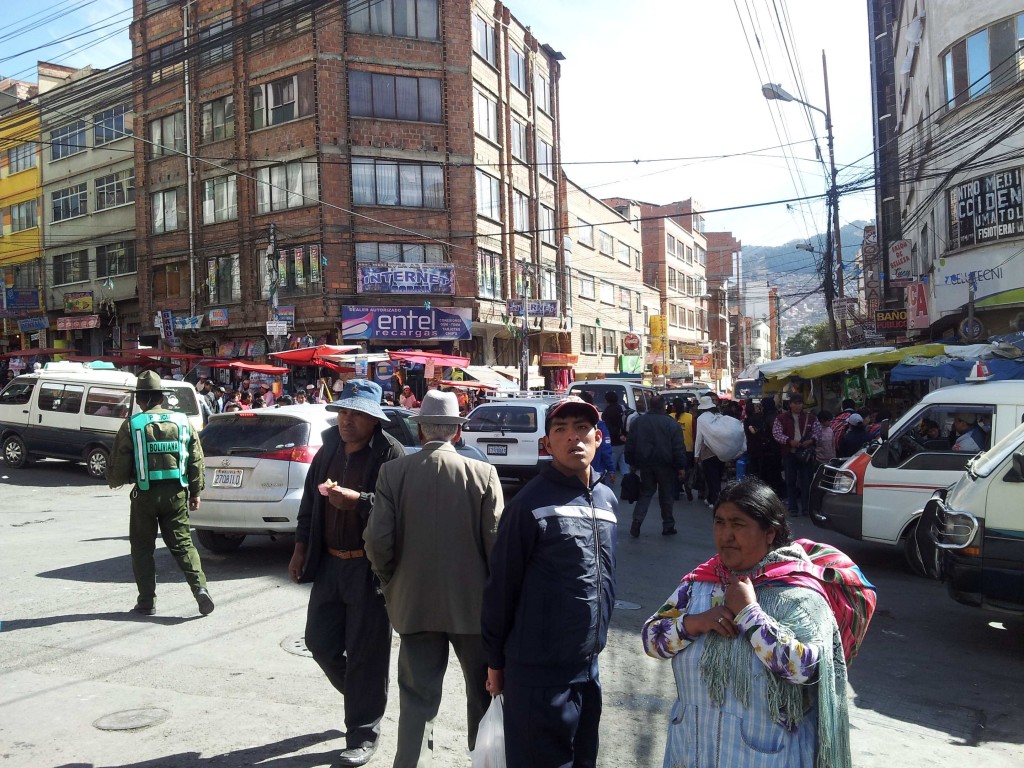
We hired a car and driver ($7usd an hour) to take us to the miradors (outlook) so we could have sweeping views of La Paz and get to see the area as La Paz is a big, long, valley. I will leave those photos for Ryan to post.
Like many parts of this trip, we really had just a vague plan for leaving. We had plane tickets from Juliaca, Peru on Monday evening. You may remember Juliaca from an earlier post, we drove through on our way to Puno and it was by far the worst city we visited on the trip. Julica has an airport because it is on the altiplano. Puno, an hour away, has no flat land for an airport. Our plan was to travel by bus from La Paz to Puno and spend the night, visiting friends and then take a collectivo to Juliaca and fly to Lima. And then… maybe get a bus to km 41 where our beach house is? The Lima airport is actually in Callou so km41 is really about 80km away.
On Saturday night, we asked the hotel about leaving in the morning and they said it was too late to buy tickets as the tourist bus leaves at 8am, before the station opens. We decided to figure it out ourselves so we got up early and walked (uphill) to the bus terminal (which was another building designed by Eiffel as was the train station) and bought non-tourist bus tickets to Puno for $90 bobs ($12usd). We then had plenty of time as the bus did not leave until 1pm so we went searching for vegetarian saltenas (successfully!) and then bought a few last minute items (alpaca leather soles for slippers) and then headed back to the hotel to pack up. We checked out, our hotel bill wildly fluctuated being $210 when we checked in but ending up being only $184 when we left. We gave the hotel front desk clerk Noella our Lonely Planet Bolivia book (they had a really old one, 1984) and a Lonely Planet English phrase book that many people have coveted on this journey and now she and Ryan are Facebook friends.
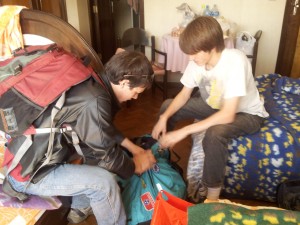
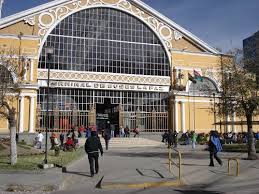
We made a fast last minute stop at the grocery store as our experience in Peru led us to think that we would have very limited choices. We spent $57usd and stuffed our duffle bags with coconut milk, no-sugar-added tomato sauce, a lot of spices and seasonings, fine cheese and other items.
We left La Paz with a bag of vegetarian saltenas in our backpacks and our duffle bags filled with fine Bolivian chocolate, a bottle of Bolivian Riesling (there is a cult following of this wine as Bolivia does not export wine or chocolate), Bolivian cheese and gifts.
Our bus left at 1pm. We had to be at the bus terminal at 12:30. When we arrived, the woman we bought our tickets from told us we were in the wrong place – we needed to go to the bus STATION. So she grabbed a taxi and hopped in with us (!) and took us to the station which is in El Alto. She called the driver to make sure he waited for us. It was a very nice thing to do. And she paid for the taxi.
Jack and I sat behind a couple drinking chicha. After an hour, we picked up a smelly American who smelled like bad pizza. We had to cross part of Lake Titicaca where there is no bridge. The bus stopped and we all get off and the bus backs on to a rickety raft. The raft slowly floats across Lake Titicaca. The passengers get into an equally slow raft but it has a roof. We theorize this is to prevent a massive bus sinking tragedy where people are trapped inside. This takes over an hour.
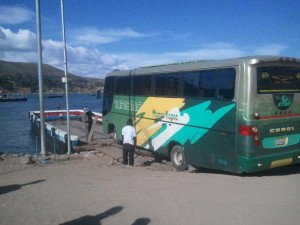
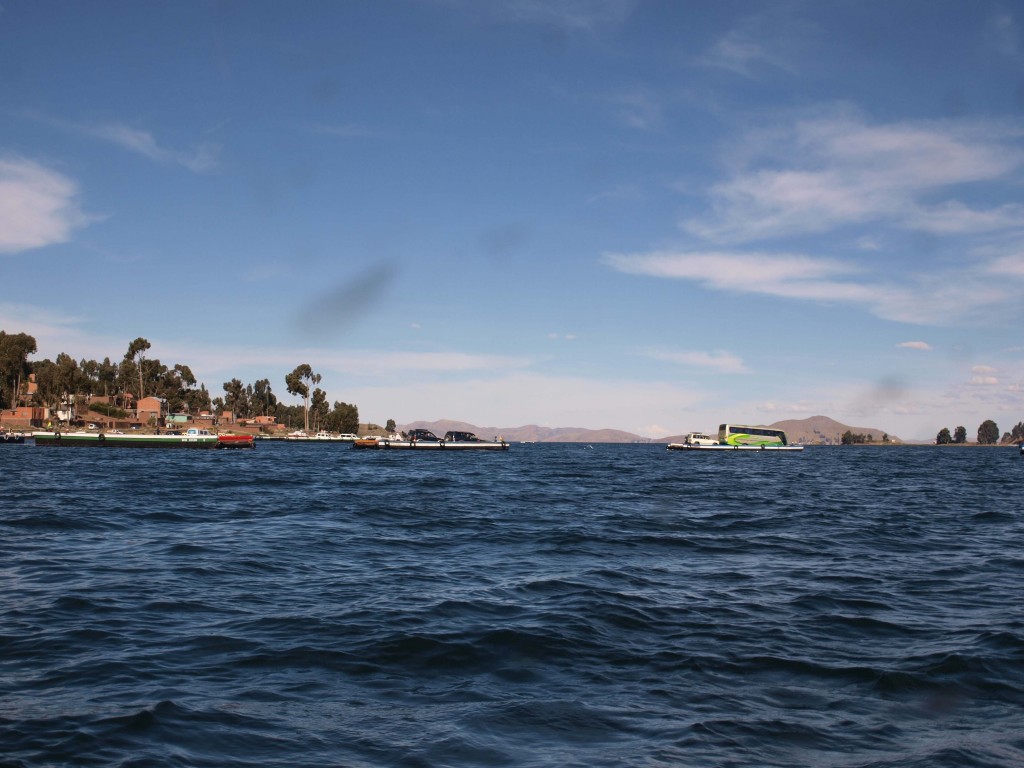
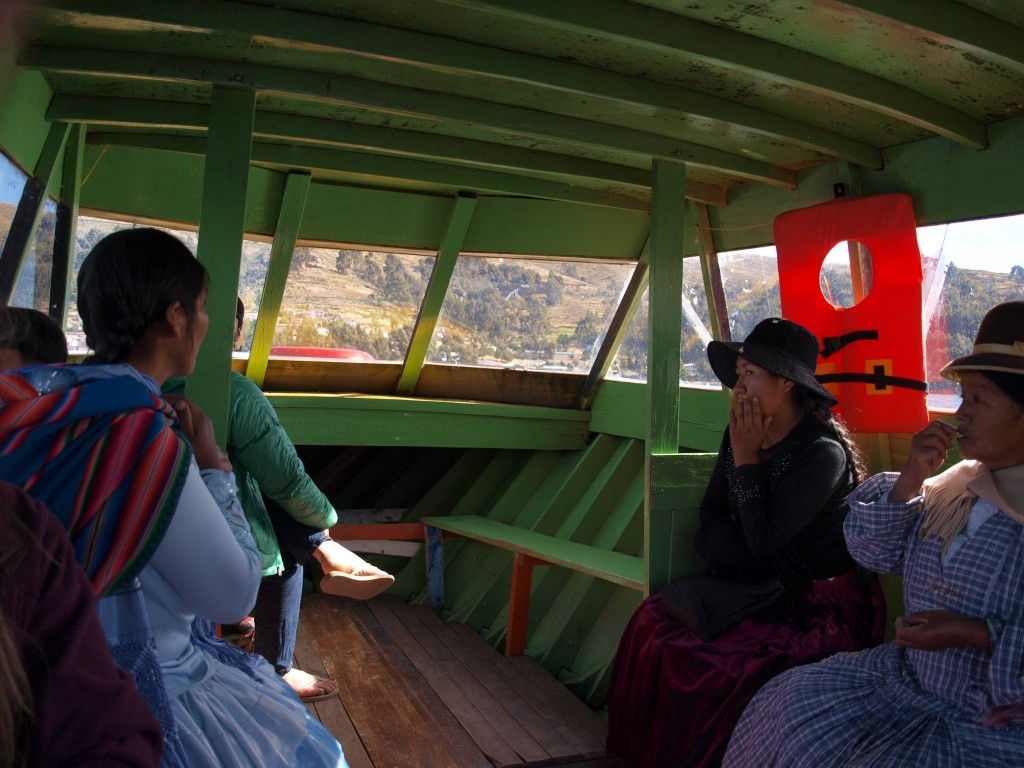
We arrived about 5pm in Copacabana and it was AWFUL. It was some kind of festival day, or perhaps just Sunday, cannot really know as everyone, EVERYONE was completely staggering, vomiting, lurching, peeing themselves drunk. Dogs and babies ran everywhere. The Plaza de Armas was covered in broken glass bottles, garbage, dirty diapers, and even less attractive items containing bodily fluids. There was a public bathroom in the square and for 1bob each, we all went inside. Men peed everywhere in the square, which was cement, so there was literally a river of urine. The women’s bathroom had women so drunk they could neither close the door nor manage to hit the toilet. There was also quite a lot of blood. Blahhhhhhhhh. We went to our bus office and there was a mistake on our ticket. The kind woman who took us there in a taxi had filled the ticket out wrong and put the wrong time on it. The Copacabana bus office said we had to wait until tomorrow. Ryan came back and told me this and I looked around at the dogs eating dirty diapers and the cholita ladies fighting in the street and walked over to the bus station and begged them to let us go on the 6pm bus. And they did! We went on a tourist bus which means it was filled with only tourists, kind of a unique situation for us. We took our seats and the bus filled with Germans, Austrians and Dutch folks. The seats were off by one number (ABC – JLM, no K) and none of the Germans could deal with this. A Czech couple got on the bus and found Germans in their seats and a huge argument ensued. The bus driver had to settle the argument but the Czech couple spoke no Spanish and no English (truly the universal language!). We drove for an hour and the bus stopped and we all got off and went through customs and exited Bolivia. We exchanged some money (USD and Bolivianos for Peruvian sols, we still had some Chilean pesos to exchange) and walked across a bridge into Peru where we were stamped into Peru and got on the bus and drove to Puno. We arrived at 9pm and stayed at a lovely hospedajea near the centre. Jack was not feeling too good so in the morning, Ryan and I went to the tower hotel / restaurant Qalasaya where we used to hang in our Puno days and were again the only people there. We had Nescafe and a stunning view of Lake Titicaca.
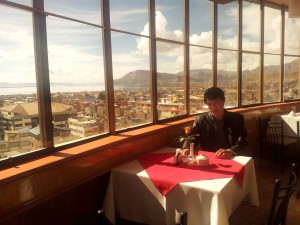

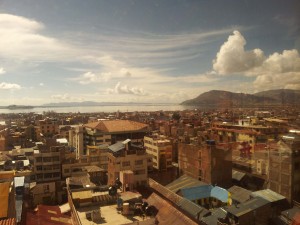
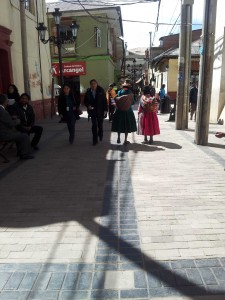
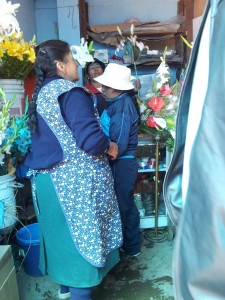
We wandered around Puno and bought a few last things that people wanted but we did not buy when we were there – a sweater for Annabelle, a shawl for Sylvia. We have not been very big on souvenirs this trip so I wanted everyone to have at least one thing they wanted to have. Then we caught a collectivo to Juilaca. A collectivo is a collectively owned minivan that holds at least 15 people with seats. Luggage goes on top under a stretchy net. The collectivo was 3 soles each (about $1.15usd). The tourist bus was $15usd each. The collectivo drove around Lake Titicaca as the sun set on the Andes peaks and the altiplano, a beautiful drive. It was dark when we arrived in Juliaca and there were no taxis. You see, Peru has few taxis as most people use and drive motos. A moto is a motorcycle fitted with a passenger seats and totally tricked out with LED lights, batman decals, antennae, dingly balls, pictures of Jesus. fringe…
You cannot fit our bags into the moto. We would have needed 5 motos. We were holding out for a cab. Four different people cam and told us to watch our stuff as it was not a good neighborhood. Great news. I told Ryan to go ask someone to call us a taxi while I stood guard by our bags. Not too long later, a taxi arrived and took us to the Juliaca airport where we caught the LAN plane to Lima. We arrived in Lima and negotiated a taxi 82km to our beach house. Mark was waiting by the gate and we hauled all our gear to the house. And that is the end of our Bolivian Adventure!
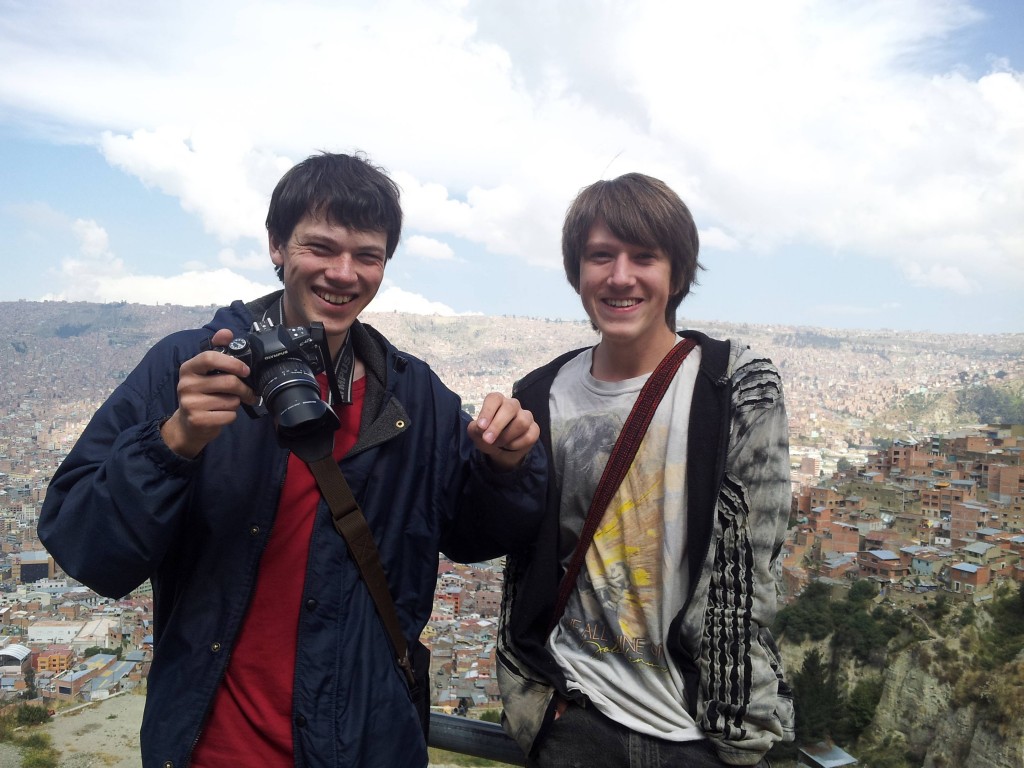
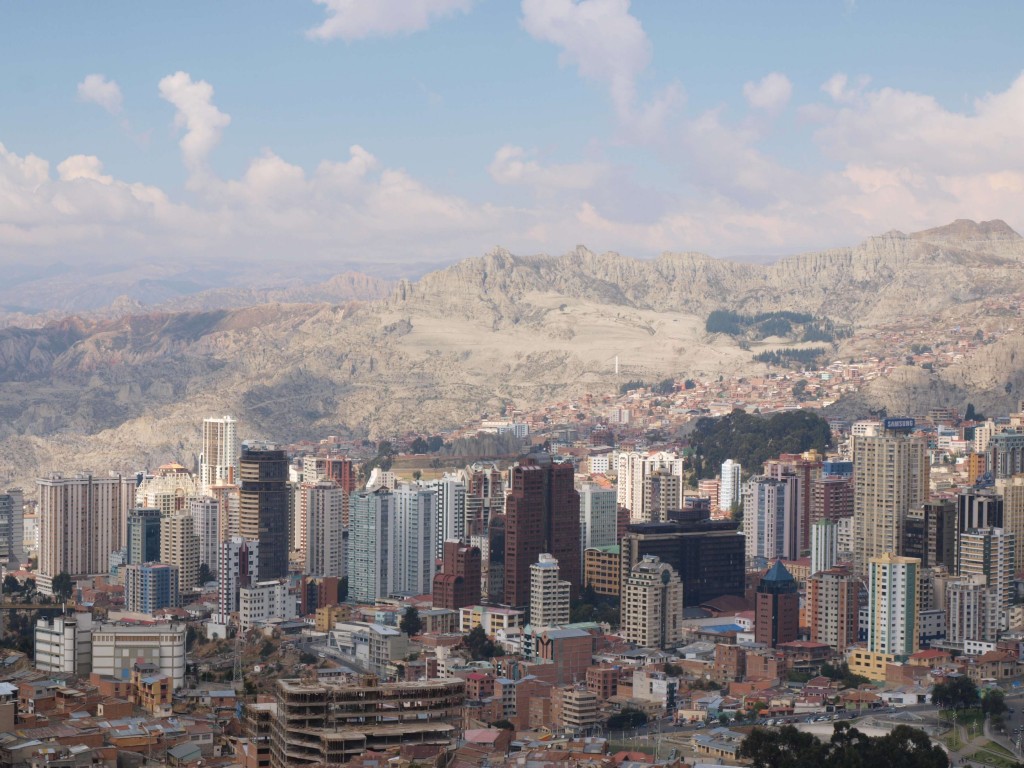
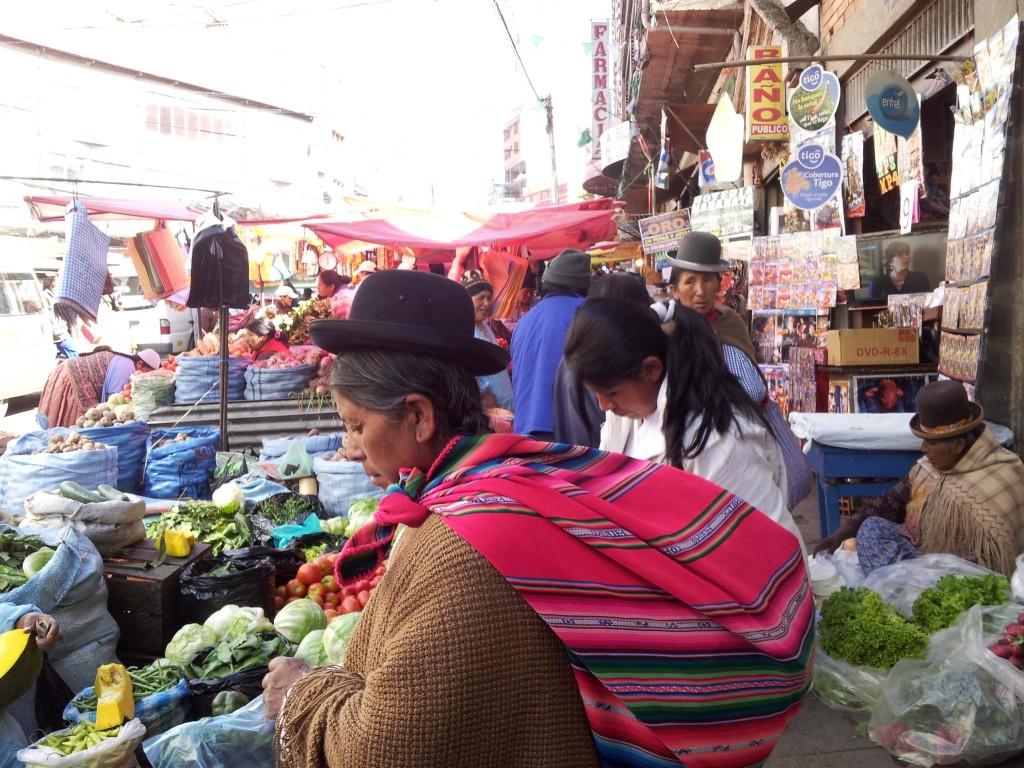
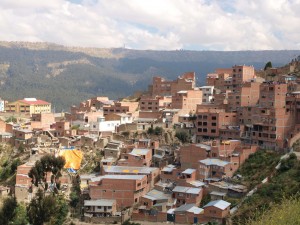


3 Responses
Aunt Pat
WOW!! Thank you all so much for taking the time to write all of this. Gram and I pop popcorn get comfy, and settle in and I read her every word, We love it! sounds like an amazing time, love you guys, Have fun
Stacy
That is not at all how I would have envisioned Copacabana!
Grandma Kay
Fantastic colorful entry Thanks for sharing it all with us!
Love you guys sooooo much! Be safe, be happy